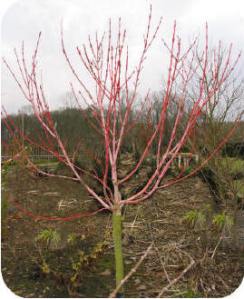Acer pensylvanicum ‘Erythrocladum’ of ‘Koraalesdoorn ”
Rare trees in the winter have something to offer and also not too large, are now very popular! The choice of trees for an average garden is unfortunately limited. The crown size may not be too large so that the view of the environment is maintained. A beautiful tree that conforms to these standards, the Acer pensylvanicum ‘Erythrocladum.
Our nursery has several small permanent http://www.HortusConclusus.be rare trees and moreover, it is our specialty! These are usually a small tribe breeds and can thus easily be used as a balcony or patio plant in a pot. The big advantage is that you have these trees in winter may be just outside it!
The intention is to at least one article per month on these rarities here to publish.
1. Naming:
Genus: Acer
Type: pensylvanicum
Cultivar: ‘Erythrocladum ”
Family: Aceraceae
Dutch name: snake-bark, snake bark maples or snakeskin
English: Snake Bark Maple
Origin: North – Northeast V. S. of America.
Hardy: Very good, even in pots! Zone 3 to Zone 7.
Ordinary Acer pensylvanicum Aceraceae and the family is part of a group of maples, which is ranked among the snake bark maples maples or snakeskin. In English referred to as snake bark Maples. He has not stolen its name because the strains of this group exhibit striking white-gray vertical stripes on the trunk. The pattern of this, with a little imagination sometimes beautifully marked resemblance to the skin of a snake. The gray stripes are wasstrepen.
Acer pensylvanicum is originally from northern to northeastern United States. In the young stage is primarily a tribal sight.
2. The variety Acer pensylvanicum ‘Erythrocladum’:
The rare variety ‘Erythrocladum’ hand requires less maintenance. The foliage is more beautiful and intense golden yellow fall color is even more pronounced than in the ordinary variety, as early as the fall the beautiful red coral branches (Erythrocladum ‘), contrasting with the golden leaf on it. Moreover, the flowers are very striking in the spring! He has a compact growth and is not higher than 3 to 4 feet!
The flowers of Acer pensylvanicum ‘Erythrocladum’ appear in May and are bright yellow with brown spots. They are usually on top of fresh green leaves and hang in long clusters throughout the tree. The seeds are the typical property that prevents all maples, that winged seeds are dispersed by the wind.
Striking the maple leaves and branches. The young leaves are initially narrow, small and oval, but then develops into a three-lobed leaf that young plants can be up to eighteen inches wide! The lobes are forward looking and focused briefly. The magazine is on relatively short, red to red-green steal from three to four inches long.
The branches in the spring and summer just green with white-gray stripes. As soon as the autumn in the country, discoloring the coral branches. The striped white-gray bark is more intense than that seen on coral red background. It looks like a red dogwood on a trunk grafted …
3. Propagation of Acer pensylvanicum ‘Erythrocladum’ by slips:
The only way to increase this variety by grafting. It is possible Acer pensylvanicum ‘Erythrocladum’ on a rootstock to graft from his family. On tall, half-standard or low strain, this attractive, small graceful tree on.
In a short rootstock remains maple look like a shrub. The grafted plants on our selected rootstocks are much better able to poor soil conditions than when grafted on an Acer pensylvanicum. So he thrives on almost any soil, even heavy clay.
The preference is for a good humeuze, slightly moist soil. While Acer pensylvanicum ‘Erythrocladum’ naturally prefer partial shade in the stands, he does well in full sun provided the soil is not too dry.
It is possible the shrub before or after the winter to transplant.
4. Pruning:
Acer pensylvanicum ‘Erythrocladum “as a young tree bought scarcely needs to be pruned. Remove only intersecting shoots or branches from the strong side branches toward the trunk to grow inside. This keeps the light crown and is sufficient sunlight to the leaves. This is necessary to sunlight during the summer, enough sugars to make in the fall to use the superb golden discoloration of the leaves and coral red discoloration of the twigs.
Prune in the autumn when all the leaves of the tree has fallen. Rejuvenation pruning do not apply. There are rarely shoots made strong enough to form a new constitution.
Acer pensylvanicum ‘Erythrocladum’ can also be grown as a shrub with a trunk for use in a pot for patio or balcony. In this case, the central leader removed, but then pruning the top two to three pairs strong laterals away. Prune weak shoots grown on the trunk road. Young maples may be damaged by the winter freeze on the extreme tips of the shoots, but it is rare. If this happens, then pruning the top (s) back to an outward eye. In pot will grow more compact and slower anyway. Our winters he wins without any problems.
5. Summary:
Light: Sun or partial shade.
Height: A compact growth, no larger than 3 to 4 meters.
Flowering time: April – May
Flowers: yellow with brown spots, hang in long clusters throughout the tree.
Soil pH: Humeus – neutral, translucent.
Type: Shrub, small tree or tree trunk (grafted).
Plant Characteristics: Three-lobed bright green leaves to eighteen centimeters. Strain bears a striking white-gray stripes.
Autumn Colour: Intense golden yellow fall color with beautiful red coral branches (Erythrocladum ‘)
Fruit: The seeds are the typical property that prevents all maples, that winged seeds are dispersed by the wind.
Pruning Tips: in the autumn when all the leaves of the tree has fallen. Rejuvenation pruning do not apply.
Use: flowers, bee plant, autumn color.
